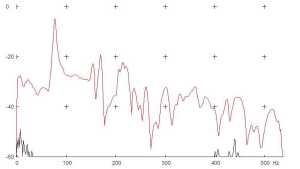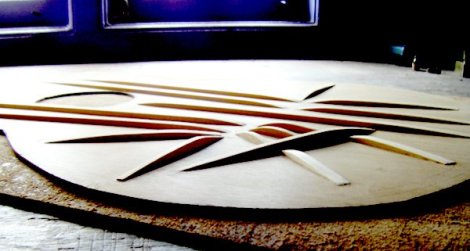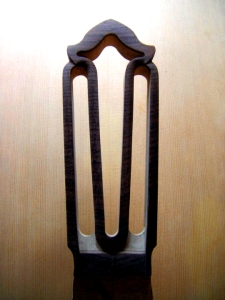Concerning aesthetics my approach is to seek a sense of purity and equilibrium which is rooted in the curves themselves. Before considering decorative elements that I would qualify as secondary, as purflings, rosettes, inlays, the outline of the instrument must contain a poetic impression. Speaking by themselves, curves do not require extra embellishment, which is why I have a preference for purflings and other secondary decorative elements that are relatively minimalistic.
Wood:
Here aesthetics considerations are intimately linked to acoustical and structural considerations. Although there is a fairly set tradition regarding the use of specific woods for specific instruments, I often stray away from these rules especially when the targeted sonorities are purposedly outside the traditional acoustic envelope of the instrument being developed. Some examples of these experiments are the use of Ebony for the back and sides of classical guitars, Mahogany violins, Padauk cellos…
Space-age materials:
Technological developments of the last few decades, partly fuelled by space research, have brought new materials with out-of-the-ordinary acoustical and structural properties which are now slowly making their way into mainstream lutherie. Carbon fibers or graphite allow for very light yet rigid structures. I reinforces my instruments neck with it to considerably minimise energy losses wich contribute to a greater sustain and a better stability over time and weather changes. Depending on the desired tonal balance.
I also use carbon fibers to reinforce the bracings on the top, back, and sides. The amount of graphite used has a marked effect on the final acoustic behaviour of the instrument, broadening the dynamic range and increasing the response to the player’s expressive variations, but at the same time taking the whole envelope into a more modern domain. I also experiment with nomex double tops, titanium and kevlar.
Design and building concepts:
The present state of Lutherie is the result of centuries of empirical evolution which has brought the instruments we now play to a level close to optimal which makes improvement very difficult. It is especially the case for the violin whose dimensions haven’t changed since Antonio Stradivari. The guitar too, although having a wider variety of shapes and designs for various musical style becomes very difficult to improve.
When analysing the sound of my instruments I divide its acoustical criteria into two categories : the objective criteria and the subjective ones.
The main objectives acoustical criteria are : Volume (amplitude), Sustain, Dynamics, Clarity or Separation wich is the capacity of the instrument to produce multiple notes or chords with each note being audible individually, and Homogeneity wich is the even repartition of all these criteria over the whole range of the instrument. All these criteria are based on physical characteristics of sound, in the scientific sense, and can all be measured and visualised, notably with software tools. These criteria are thus not tributary of any auditive fashion of any epoch or musical style.

Coil driven response graph of a KII nylon string guitar, showing a strong peak just around 80Hz, near the low E string’s frequency. This graph shows objectively that the guitar in question has a “true bottom”
In contrast, the subjective criteria are very difficult to define because they rest in the artistic domain and appeal to our artistic and emotional side, where vocabulary or standardisation of concepts is scarce and undefined. This difficulty of definition is reflected in the fact that there is no common terminology to describe these criteria. We then use subjective imagery like “warm”, “round”, light”, “this guitar is darker than this one” or even as a client once wrote to me : “the bass are so good I feel like ripping my fingers off on it !” , which illustrates the lack of terminology when it comes to describing the subjective experience of sound.
All the subjective criteria are based on a combination of objectives criteria, for example a guitar described as “warm” is very likely to have a stronger fundamental in its harmonic spectrum than a guitar qualified as “dry”.
The rest is Music …
Alexandre Letellier – Luthier




Nice site!
I noticed that you have subscribed to my blog. Would request you to follow me on http://www.bigfootguitars.com , as the blog has recently shifted there.. thanks, and keep up the good work!